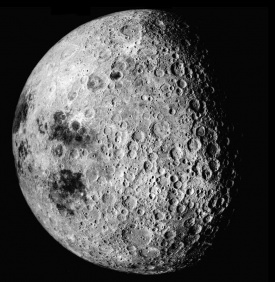Luna
| Luna (The Moon) | |
 | |
|---|---|
| Star System: | Sol |
| Galaxy: | Milky Way Galaxy |
| Condition: | Uninhabitable |
| Atmosphere: | Variable |
| Surface Gravity: | 0.1654 G |
| Natural Satellites: | Natural Satellite of Earth |
- For the ship of the same name, see SFCV Luna.
| “ | Here men from the planet Earth first set foot upon the Moon July 1969, A.D. We came in peace for all mankind | ” |
| — Apollo 11 Lunar Plaque | ||
Luna is the only natural satellite of Earth, third planet in the Sol System. While explored numerous times in manned missions, primarily by the United States of America in the 1960s and 1970s, ending in the latter years of the Cold War. Later follow-up missions were primarily robotic, from a variety of nations.
The lunar surface is rocky, pitted with large numbers of craters, many of which have been tentatively traced to impacts from meteors and asteroids. A number of large basins on its surface are referred to as "Seas", complete with bays, despite the lack of any natural liquid water on the moon.
Despite the first manned lunar landing being in 1969 CE, a number of unmanned landings provided huge boosts to scientific understanding, and even prior to any exploration of the moon from or near it's surface, the moon has provided great amounts of scientific data.
Prior to the Fall of Earth, The Initiative had established an outpost on the Lunar Surface, which was abandoned following the end of the war. At least one known United Earth Fleet vessel has crashed on the surface of the moon, the cruiser UEF Washington (CS1).
| Worlds of the Initiative | |
|---|---|
| Worlds and Colonies | |
| Core Worlds: | Sanctuary • Tyr • Ares • Arxune • Arkadia • Tien |
| Colony Worlds: | Asam • Aella • Oya • Dwyn • Emer • Kapu • Arshile • Taelbern • Teresh |
| Asteroid & Orbital Colonies: | Arc 2 Prime • Arc 2 Alpha • Arc 2 Bravo • Pedras • M4 Prime • M4 Omega |
| Outposts: | Hermes • Charadan • |
| Orbital Platforms | |
| Civilian & Military Platforms: | Torr Hernn • Jäger Tor • Tannhäuser Tor • Isheim • Vorota Zari |
| Military Platforms: | Porth Llongau • Steintor • Soldat-Tor • Sojourner |